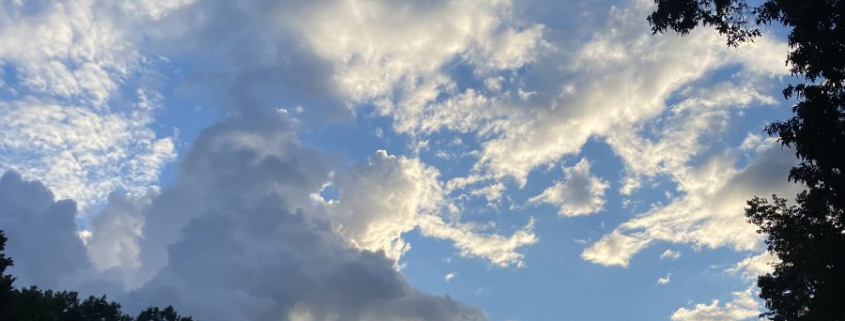A Bounty of Observations from an Empty-Basket Foraging Hike
Wednesday afternoon August 24, 2022, fellow mushroom forager Dr. Bernie Kerecki (MD) and I bushwhacked through a riparian hardwood forest just north of the Tennessee River in Madison, Alabama. We stayed alert for chanterelles, oysters, chicken of the woods, hen of the woods, black-staining polypores, cauliflower mushrooms, wood ear jelly, and lions mane, all of which we have previously collected in prior outings. We exited the closed-canopy forest when declining light limited our ability to discern edibles on the forest floor. We left with empty collecting baskets. Here’s a typical view of the forest floor we scoured for 90-minutes, seeking more than seedlings, herbaceous plants, and early leaf-falls.
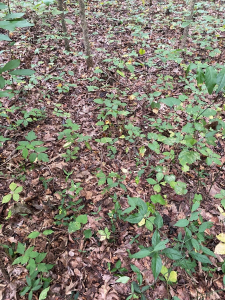
In contrast, here is a photo of the chanterelle-rich forest floor from summer 2021, just twelve months ago. Last year, my first as a semi-serious wild edible mushroom forager, did not prepare me well for this recent empty-basket venture, nor for the several prior trips this season that yielded only sparse harvests. The 2021 calendar year served as a real spoiler. I’m convinced that, like all else in Nature, mushroom production is cyclical. I hope that 2022 is an off-year…an unusually poor season of production that will be followed by seasons more typical of 2021.
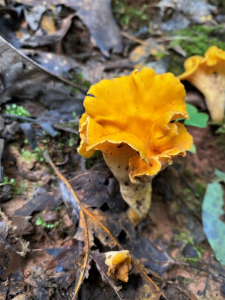
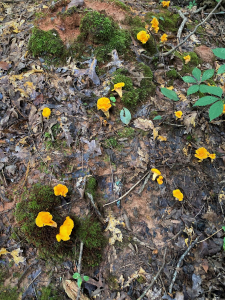
I recorded this 90-second video capturing what I call A Chanterelle Forager’s Woe:
Nature’s Revelations and Rewards
Now, lest you surmise that I viewed this woodland ramble as a waste of time, let me share with you the bounty of Nature revelations and rewards I did, in fact, gather. I am a sucker for big trees. Although I have visited the US forests of true giants: coastal redwoods, Sierra Nevada sequoias, and Douglas fir, I have learned, with each return to our eastern forests, to recalibrate so that I can once again marvel at and appreciate the simple grandeur of a 40-inch southern red oak standing 110 feet tall. I refused to let my empty basket diminish my appreciation of such a forest beauty. Modifying a turn of phrase from Aldo Leopold, I love trees, yet I am in love with oaks. For Leopold, the object of his sylvan affection was white pine.
A Mighty Oak
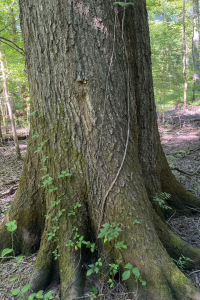
I recorded this 3:40 video to paint a clearer picture of this riparian forest and the mighty oak within it.
Toppled Crown Segment from Another Mighty Oak
The three-foot-plus diameter (breast high; dbh) southern red oak below marks the spot where on dozens of prior occasions I turned west from a long-abandoned lane through the 70-90 year old natural hardwood forest. This tree predates the current forest, a relic that persisted from logging when the Corps of Engineers acquired and cleared the lands adjacent to the future Lake Wheeler. The tree bears evidence that at some point long ago it sustained mechanical injury, opening a court of infection for decay fungi.
I included the two photographs below on this same oak in my September 1, 2020 Post, offering this paragraph:
Other trees evidenced signs (not just symptoms) of certain degradation and reduced vigor, vitality, and value. This 30-plus-inch diameter oak still has a vibrant crown, yet is clearly hollow, likely home to critters of various sorts. Fungal fruiting bodies (to the right of the trekking pole below right) evidence dead wood along a vertical seam. I pondered why this large diameter oak appears to be long-hollowed. My forensic forestry yielded an answer. This oak is a residual from the mid 1930s logging, perhaps too small to harvest, damaged by that operation, and left to populate the new forest. The scarred trunk served as an infection court for decay fungi. It has lived with the decay for nine decades, inconvenienced but not fatally limited. As a surviving remnant in the new stand, it likely stood 30-40 feet above the regenerating stems, and had advantageous access to sunlight as well as soil nutrient and moisture resources. I have no idea how many more years it will withstand the stresses of decay, wind, ice, and gravity.
I’m pleased that my story has changed little. The view to the left is to the south; to the east at right, with the old lane just beyond.
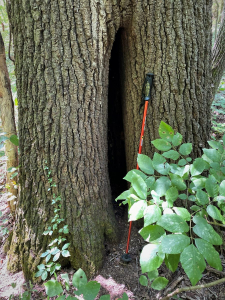
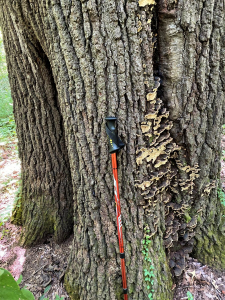
Here’s the current view from the old lane looking west. The massive crown segment lies across the old lane, extending another 40-plus feet across the lane to the east.
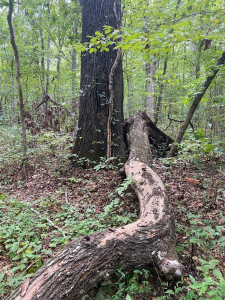
The fork broke loose from the crown forty feet above the ground (see magnified view at right).
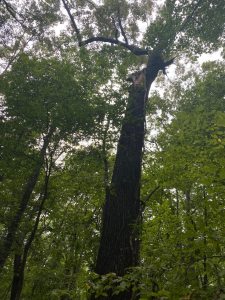
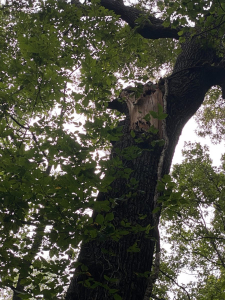
I estimate that the crown occupied one-fifth of an acre, calculated by its stretch of 55 feet in all directions from the tree’s base. Half of the fork reaches to the east (left); the other major portion stretches at least fifty feet westward (right). Note that each stub shows that the heart rot extended forty feet above that long-ago basal wound that welcomed decay fungal spores. The decay organism has been hard at work for many decades. How long will the decay organism live? Until the standing tree’s strength to weakness threshold reaches a point of inflection, toppling the entire structure. Nothing in Nature is static.
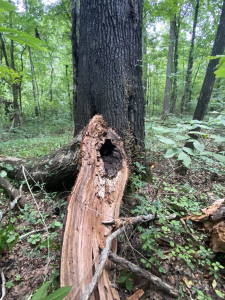
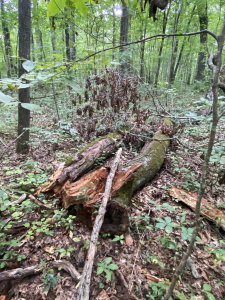
Here is the current view of the tree’s north side, the massive fork at nearly 30-inches in diameter lying where it dropped at the tree’s hollow base. In the short period (less than a month) since the top fell, wood-boring beetles have already infested the wood. See the telltale wood dust signatures at each point of entry. I am in uncomfortable territory here, some five decades after my undergraduate entomology courses. I believe that female adults intent upon depositing eggs within the inner bark are responsible for the dust. Having done their duty, I think that the resultant larvae will consume the cambium and sapwood. Each entry point will allow fungal spores to enter. Fungi will begin their feeding. Eventually the massive top will return to the soil. Nothing in Nature is static!
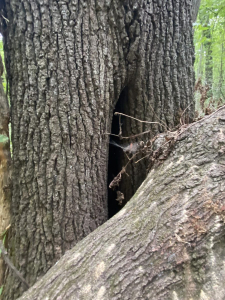
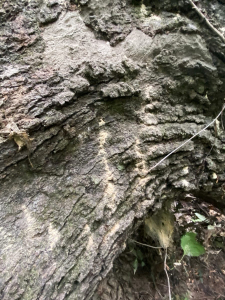
Here’s the 3:31 video I recorded:
From a Mighty Oak to an Understory Red Buckeye
My hometown (Cumberland, Maryland) neighborhood had a few yellow buckeyes. I loved collecting their distinct nuts in autumn. I don’t recall their special utility; I simply found them attractive…worthy of collection. Our northern Alabama woods have a few main canopy yellow buckeye trees. The red buckeye, a shrub to lower-canopy tree (less than 15 feet), is much more common. Its fruit is very similar to its yellow buckeye kin. Many decades removed from my childhood buckeye collecting, I still enjoy finding its special fruit. These weren’t yet ripe.
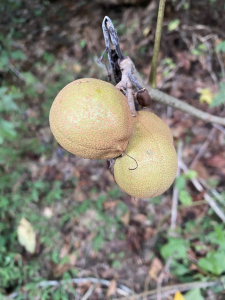
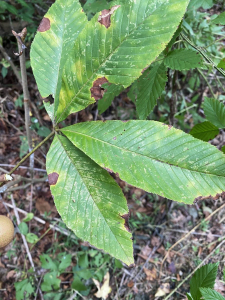
A Early Evening Farewell
The dense riparian forest shade deepened early, limiting our foraging vision. We exited the woods well before the sun crossed the horizon, and lucky for us we departed in time to catch the grand evening firmament show. We departed the forest at the edge of a soybean field, presenting a sky-view to the west. A few dying cumulus against a cerulean sky above the darkening field and wood edge more than compensated for our hapless foraging efforts.
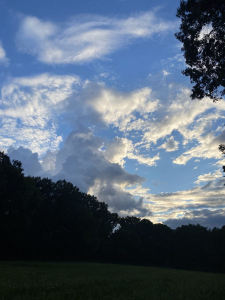
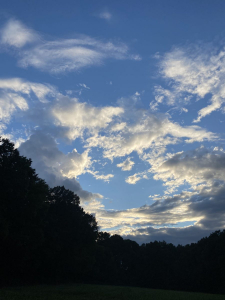
I found breathless fulfillment in this gift of heavenly elegance.
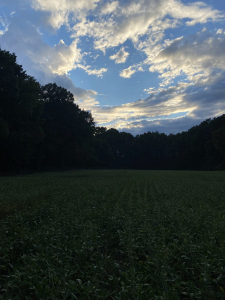
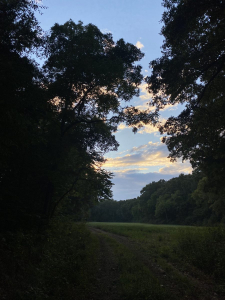
As he so often did, Muir captured my feelings a near-rapture:
The world’s big and I want to have a good look at it before it gets dark.
And into the forest I go, to lose my mind and find my soul.
I only went out for a walk and finally concluded to stay out till sundown, for going out, I found, was really going in.
In every walk with Nature one receives far more than he seeks.
The sun shines not on us but in us.
An empty basket? Not even close! No, we brought no mushrooms home, yet our harvest was ample. Allow me to modify another Muir quote:
Everybody needs beauty as well as mushrooms, places to play in and pray in, where nature may heal and give strength to body and soul.
Another outing in Nature — another harvest necessary to sustain body, heart, mind, soul, and spirit!
Thoughts and Reflections
I offer these thoughts:
- Even with an empty mushroom foraging basket, a forest harvest can be in soul-form!
- The world’s big and I want to have a good look at it before it gets dark. (Muir)
- Inhale and absorb Nature’s elixir!
Note: All blog post images created & photographed by Stephen B. Jones unless otherwise noted. Please circulate images with photo credit: “©2022 Steve Jones, Great Blue Heron LLC. All Rights Reserved.”
Another Note: If you came to this post via a Facebook posting or by an another route, please sign up now (no cost… no obligation) to receive my Blog Post email alerts: http://eepurl.com/cKLJdL
And a Third: I am available for Nature-Inspired Speaking, Writing, and Consulting — contact me at steve.jones.0524@gmail.com
Reminder of my Personal and Professional Purpose, Passion, and Cause
If only more of us viewed our precious environment through the filters I employ. If only my mission and vision could be multiplied untold orders of magnitude:
Mission: Employ writing and speaking to educate, inspire, and enable readers and listeners to understand, appreciate, and enjoy Nature… and accept and practice Earth Stewardship.
Vision:
- People of all ages will pay greater attention to and engage more regularly with Nature… and will accept and practice informed and responsible Earth Stewardship.
- They will see their relationship to our natural world with new eyes… and will understand more clearly their Earth home.
Tagline/Motto: Steve (Great Blue Heron) encourages and seeks a better tomorrow through Nature-Inspired Living!
Steve’s Three Books
I wrote my books Nature Based Leadership (2016), Nature-Inspired Learning and Leading (2017), and Weaned Seals and Snowy Summits: Stories of Passion for Place and Everyday Nature (2019; co-authored with Dr. Jennifer Wilhoit) to encourage all citizens to recognize and appreciate that every lesson for living, learning, serving, and leading is either written indelibly in or is powerfully inspired by Nature.
I began writing books and Posts for several reasons:
- I love hiking and exploring in Nature
- I see images I want to (and do) capture with my trusty iPhone camera
- I enjoy explaining those images — an educator at heart
- I don’t play golf!
- I actually do love writing — it’s the hobby I never needed when my career consumed me
- Judy suggested my writing is in large measure my legacy to our two kids, our five grand kids, and all the unborn generations beyond
- And finally, perhaps my books and Blogs could reach beyond family and touch a few other lives… sow some seeds for the future


All three of my books (Nature Based Leadership; Nature-Inspired Learning and Leading; Weaned Seals and Snowy Summits) present compilations of personal experiences expressing my (and co-author Dr. Wilhoit for Weaned Seals and Snowy Summits) deep passion for Nature. All three books offer observations and reflections on my relationship to the natural world… and the broader implications for society. Order any and all from your local indie bookstore, or find them on IndieBound or other online sources such as Amazon and LifeRich.

